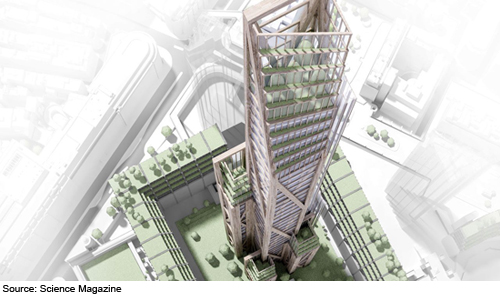 One of the many things we strive to do for you at Construction Citizen is keep up with current trends in the industry. Admittedly, my friend Jim Kollaer does a better job of it than I do - whether it’s twisted towers, the role of drones in construction, or 3D printing. You can see all of Jim’s articles here.
One of the many things we strive to do for you at Construction Citizen is keep up with current trends in the industry. Admittedly, my friend Jim Kollaer does a better job of it than I do - whether it’s twisted towers, the role of drones in construction, or 3D printing. You can see all of Jim’s articles here.
One of the particularly interesting trends emerging now is the fact that wood – yes, wood – is making more appearances as the material used for the skeletons of tall buildings in the United States and elsewhere.
Smithsonian.com just published an article about a building in Minnesota called T3 that, when completed, will be the tallest wooden structure in the US. As the publication put it, the irony of its cutting edge nature is “that its cutting-edge nature rests on an old-school material: wood.”
More from the Smithsonian article:
Building tall with timber fell out of favor in the late 19th and early 20th centuries, when new construction codes demanded brick, stone and steel, but the benefits of wood are making architects see green. Not only do mass timber buildings require less energy to build, wood fibers are one of nature’s greatest storehouses of atmospheric carbon (in the case of T3, 3,200 tons of it). The architecture firm Skidmore, Owings & Merrill (SOM) recently calculated that the carbon footprint for a 1965 42-story concrete apartment building in Chicago would have been 60 to 75 percent lower if it was made of mass timber instead.
One might think those environmental benefits could be canceled out by the fact that many people wouldn’t find it safe to work or live in a skyscraper made of wood instead of steel. On the issue of safety, Science Magazine took a look at the strength of the material:
A Douglas fir tree is a marvel of natural engineering. The trunk, made mostly of slender dead cells each a few millimeters long, can reach heights of 100 meters. It's supple enough to sway in windstorms without snapping, yet strong enough to support its weight—up to 160 metric tons. Kilogram for kilogram, a wooden beam made from this fir is 3.5 times stronger than steel. A single tree can store half its weight in carbon and can replace itself, given enough time. Its luminous, patterned wood can be sculpted into virtually any shape.
What about the fire danger? Wouldn’t that be increased in a wooden building over one made of steel?
The Vancouver building, assembled from composite wooden components engineered to be stronger and more fire-resistant than ordinary wood, is unlikely to remain the tallest wooden structure for long. Engineers have conceived designs for soaring wooden skyscrapers that, at up to 80 stories, would rival their steel-framed cousins. But wood's true potential for 21st century cities is likely to emerge in the lab, where scientists are conducting myriad torture tests on new designs for wooden walls, beams, ceilings, and floors. Their goal: to see whether wood can overcome the safety concerns that, in the past, helped relegate it to the little leagues.
One architect told the magazine that there’s a lot more to figure out about how to go forward, but wooden skyscrapers are an attractive proposition for many reasons.
"We're in sort of the early, early days of this," says Michael Green, a Vancouver architect who has gained international attention for evangelizing about the potential for tall wooden buildings. "Right now I liken it to kind of the beginning of the steel revolution 120 years ago."


